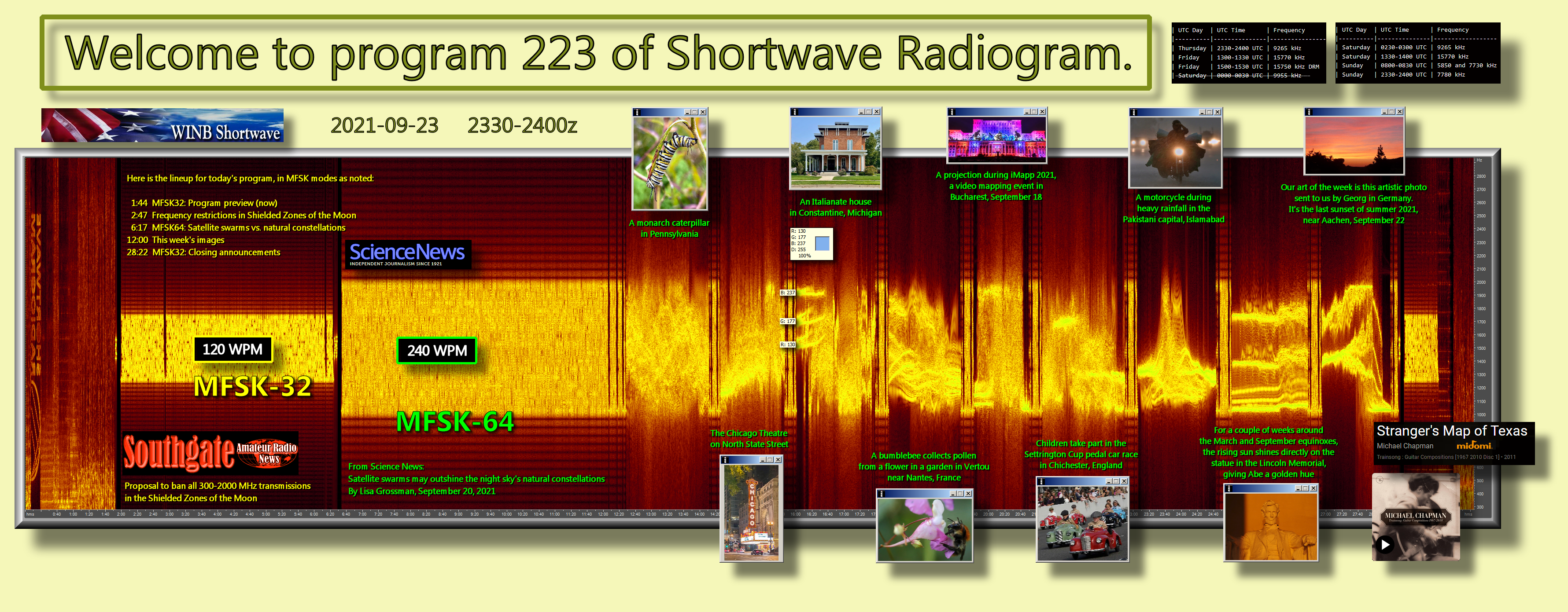http://www.rhci-online.net/radiogram/radiogram.htm

http://www.rhci-online.net/radiogram/radiogram.htm

RSID: <<2021-09-23T23:31Z MFSK-32 @ 9265000+1500>>
Welcome to program 223 of Shortwave Radiogram.
I'm Kim Andrew Elliott in Arlington, Virginia USA.
Here is the lineup for today's program, in MFSK modes as noted:
1:44 MFSK32: Program preview (now)
2:47 Frequency restrictions in Shielded Zones of the Moon
6:17 MFSK64: Satellite swarms vs. natural constellations
12:00 This week's images
28:22 MFSK32: Closing announcements
Please send reception reports to
radiogram@verizon.net
And visit http://swradiogram.net
Twitter: @SWRadiogram
From Southgate Amateur Radio News:
Proposal to ban all 300-2000 MHz transmissions in the Shielded
Zones of the Moon
September 22, 2021
Inside GNSS reports on the proposal to ban all radio
transmissions between 300 MHz and 2000 MHz in the area designated
the Shielded Zone of the Moon (SZM), this would also be
applicable to Mars
The spectrum would instead be used for radio astronomy
operations, this would mean the Amateur Satellite Service
allocations at 435 MHz and 1260 MHz would no longer be available
to spacecraft in Lunar orbit such as Lunar-OSCAR 93 and
Lunar-OSCAR 94 (Longjiang-1 and 2), see
https://amsat-uk.org/2018/05/19/dslwp-satellites-lunar-orbit/
The frequencies of the spectral lines of astrophysical interest
are:
• 327.4 MHz hyperfine transition of the deuterium atom
• 1,420.4 MHz neutral hydrogen (HI) line
• 1,612.2 MHz OH radical line
• 1,665.4 MHz OH radical line
• 1,667.4 MHz OH radical line
• 1,720.5 MHz OH radical line
The Inside GNSS story says:
The Space Frequency Coordination Group (SFCG) also has defined
frequency bands allocated in the lunar region. These Radio
Regulation and Recommendations therefore apply to the lunar GNSS
frequencies, since a GNSS system made of lunar orbiters will
cover all the far side of the Moon, and therefore must not create
harmful interference on future radio astronomy observations in
that zone.
The ITU Radio Regulation defines the SZM as follows: "The
shielded zone of the Moon comprises the area of the Moon's
surface and an adjacent volume of space which are shielded from
emissions originating within a distance of 100,000 km from the
center of the Earth". Because Mars is regularly in the SZM, the
specific Radio Regulation protecting radio astronomy in the SZM
is therefore also applicable to Mars.
http://www.southgatearc.org/news/2021/september/proposal-to-ban-all-300-2000-mhz-transmissions-in-szm.htm
Read the full story at
https://insidegnss.com/the-shielded-zone-of-the-moon-protecting-radio-astronomy-from-rf-interference/
Shortwave Radiogram now changes to MFSK64 ...
RSID: <<2021-09-23T23:36Z MFSK-64 @ 9265000+1500>>
This is Shortwave Radiogram in MFSK64
Please send your reception report to
radiogram@verizon.net
From Science News:
Satellite swarms may outshine the night sky's natural
constellations
By Lisa Grossman
September 20, 2021
Fleets of private satellites orbiting Earth will be visible to
the naked eye in the next few years, sometimes all night long.
Companies like SpaceX and Amazon have launched hundreds of
satellites into low orbits since 2019, with plans to launch
thousands more in the works - a trend that's alarming
astronomers. The goal of these satellite "mega-constellations" is
to bring high-speed internet around the globe, but these bright
objects threaten to disrupt astronomers' ability to observe the
cosmos. "For astronomers, this is kind of a pants-on-fire
situation," says radio astronomer Harvey Liszt of the National
Radio Astronomical Observatory in Charlottesville, Va.
Now, a new simulation of the potential positions and brightness
of these satellites shows that, contrary to earlier predictions,
casual sky watchers will have their view disrupted, too. And
parts of the world will be affected more than others, astronomer
Samantha Lawler of the University of Regina in Canada and her
colleagues report in a paper posted September 9 at arXiv.org.
"How will this affect the way the sky looks to your eyeballs?"
Lawler asks. "We humans have been looking up at the night sky and
analyzing patterns there for as long as we've been human. It's
part of what makes us human." These mega-constellations could
mean "we'll see a human-made pattern more than we can see the
stars, for the first time in human history."
Flat, smooth surfaces on satellites can reflect sunlight
depending on their position in the sky. Earlier research had
suggested that most of the new satellites would not be visible
with the naked eye.
Lawler, along with Aaron Boley of the University of British
Columbia and Hanno Rein of the University of Toronto at
Scarborough in Canada, started building their simulation with
public data about the launch plans of four companies - SpaceX's
Starlink, Amazon's Kuiper, OneWeb and StarNet/GW - that had been
filed with the U.S. Federal Communications Commission and the
International Telecommunications Union. The filings detailed the
expected orbital heights and angles of 65,000 satellites that
could be launched over the next few years.
"It's impossible to predict the future, but this is realistic,"
says astronomer Meredith Rawls of the University of Washington in
Seattle, who was not involved in the new study. "A lot of times
when people make these simulations, they pick a number out of a
hat. This really justifies the numbers that they pick."
There are currently about 7,890 objects in Earth orbit, about
half of which are operational satellites, according to the U.N.
Office for Outer Space Affairs. But that number is increasing
fast as companies launch more and more satellites. In August
2020, there were only about 2,890 operational satellites.
Next, the researchers computed how many satellites will be in the
sky at different times of year, at different hours of the night
and from different positions on Earth's surface. They also
estimated how bright the satellites were likely to be at
different hours of the day and times of the year.
That calculation required a lot of assumptions because companies
aren't required to publish details about their satellites like
the materials they're made of or their precise shapes, both of
which can affect reflectivity. But there are enough satellites in
orbit that Lawler and colleagues could compare their simulated
satellites to the light reflected down to Earth by the real ones.
The simulations showed that "the way the night sky is going to
change will not affect all places equally," Lawler says. The
places where naked-eye stargazing will be most affected are at
latitudes 50° N and 50° S, regions that cross lower Canada, much
of Europe, Kazakhstan and Mongolia, and the southern tips of
Chile and Argentina, the researchers found.
"The geometry of sunlight in the summer means there will be
hundreds of visible satellites all night long," Lawler says.
"It's bad everywhere, but it's worse there." For her, this is
personal: She lives at 50° N.
Closer to the equator, where many research observatories are
located, there is a period of about three hours in the winter and
near the time of the spring and fall equinoxes with few or no
sunlit satellites visible. But there are still hundreds of sunlit
satellites all night at these locations in the summer.
A few visible satellites can be a fun spectacle, Lawler concedes.
"I think we really are at a transition point here where right
now, seeing a satellite, or even a Starlink train, is cool and
different and wow, that's amazing," she says. "I used to look up
when the [International Space Station] was overhead." But she
compares the coming change to watching one car go down the road
100 years ago, versus living next to a busy freeway now.
"Every sixteenth star will actually be moving," she says. "I hope
I'm wrong. I've never wanted to be wrong about a simulation more
than this. But without mitigation, this is what the sky will look
like in a few years."
Astronomers have been meeting with representatives from private
companies, as well as space lawyers and government officials, to
work out compromises and mitigation strategies. Companies have
been testing ways to reduce reflectivity, like shading the
satellites with a "visor." Other proposed strategies include
limiting the satellites to lower orbits, where they move faster
across the sky and leave a fainter streak in telescope images.
Counterintuitively, lower satellites may be better for some
astronomy research, Rawls says. "They move out of the way quick."
But that lower altitude strategy will mean more visible
satellites for other parts of the world, and more that are
visible to the naked eye. "There's not some magical orbital
altitude that solves all our problems," Rawls says. "There are
some latitudes on Earth where no matter what altitude you put
your satellites at, they're going to be all over the darn place.
The only way out of this is fewer satellites."
There are currently no regulations concerning how bright a
satellite can be or how many satellites a private company can
launch. Scientists are grateful that companies are willing to
work with them, but nervous that their cooperation is voluntary.
"A lot of the people who work on satellites care about space.
They're in this industry because they think space is awesome,"
Rawls says. "We share that, which helps. But it doesn't fix it. I
think we need to get some kind of regulation as soon as
possible." (Representatives from Starlink, Kuiper and OneWeb did
not respond to requests for comment.)
Efforts are under way to bring the issue to the attention of the
United Nations and to try to use existing environmental
regulations to place limits on satellite launches, says study
coauthor Boley (who also lives near 50° N).
Analogies to other global pollution problems, like space junk,
can provide inspiration and precedents, he says. "There are a
number of ways forward. We shouldn't just lose hope. We can do
things about this."
https://www.sciencenews.org/article/satellite-mega-constellations-night-sky-stars-simulations
See also:
https://phys.org/news/2021-09-scores-internet-providing-satellites-streak-canada.html
This is Shortwave Radiogram in MFSK64
Please send your reception report to
radiogram@verizon.net
This week's images ...
A monarch caterpillar in Pennsylvania.
https://bit.ly/3kEU2Fz ...
Sending Pic:165x208C;

The Chicago Theatre on North State Street.
https://bit.ly/2XQFCJI ...
Sending Pic:123x217C;

An Italianate house in Constantine, Michigan.
https://bit.ly/3nZ77vb ...
Sending Pic:202x162C;

A bumblebee collects pollen from a flower in a garden in Vertou
near Nantes, France.
https://bit.ly/3kwy4UN ...
Sending Pic:213x141C;

A projection during iMapp 2021, a video mapping event in
Bucharest, September 18.
https://bit.ly/3nVtv8R ...
Sending Pic:221x103C;

Children take part in the Settrington Cup pedal car race in
Chichester, England.
https://bit.ly/3ELznYn ...
Sending Pic:204x168C;

A motorcycle during heavy rainfall in the Pakistani capital,
Islamabad.
https://bit.ly/3ACpsBE ...
Sending Pic:206x158C;

For a couple of weeks around the March and September equinoxes,
the rising sun shines directly on the statue in the Lincoln
Memorial, giving Abe a golden hue.
https://bit.ly/3ADLIeK ...
Sending Pic:208x151C;

Our art of the week is this artistic photo sent to us by Georg in
Germany. It's the last sunset of summer 2021, near Aachen,
September 22.
Sending Pic:222x129C;

Shortwave Radiogram returns to MFSK32 ...
RSID: <<2021-09-23T23:58Z
MFSK-32 @
9265000+1500>>
This is Shortwave Radiogram in MFSK32 ...
Shortwave Radiogram is transmitted
by:
WRMI, Radio Miami International, wrmi.net
and
WINB Shortwave, winb.com
Please send reception reports to
radiogram@verizon.net
And visit http://swradiogram.net
Twitter:
@SWRadiogram or twitter.com/swradiogram
I'm Kim Elliott. Please join us for the next Shortwave
Radiogram.
|
Closing music SWRG#223: https://www.midomi.com/Track?trackID=100253227813169360&song=stranger%27s-map-of-texas Michael Chapman - Stranger's Map of Texas Trainsong : Guitar Compositions [1967 2010 Disc 1] • 2011 https://www.youtube.com/watch?v=CPAPR2bxvuQ&list=OLAK5uy_kAI0vejaTn-5jr4rbUiBnMo9j4TYddgnA
Obituary: |

http://www.rhci-online.net/radiogram/radiogram.htm
|
QTH: |
D-06193 Petersberg (Germany/Germania) |
|
|
Ant.: |
Dipol for 40m-Band & Boomerang Antenna 11m-Band |
|
|
RX for RF: |
FRG-100B + IF-mixer & ICOM IC-R75 + IF-mixer |
|
|
Software IF: |
con STUDIO1 - Software italiano per SDR [S-AM-USB/LSB] + beta 11 Version 2.80 (August 21, 2018) - for scheduled IF-recording |
|
|
Software AF: |
Fldigi-4.0.18 + flmsg-4.0.7 images-fldigifiles on homedrive.lnk |
|
|
OS: |
German XP-SP3 with support for asian languages |
German W7 32bit + 64bit |
|
PC: |
MEDION Titanium 8008 (since 2003) [ P4 - 2,6 GHz] |
MSI-CR70-2MP345W7 (since2014) [i5 -P3560 ( 2 x 2,6GHz) ] |
http://wiki.radioreference.com/index.php/Decoding_the_SW_Radiogram_Broadcasts
https://www.qsl.net/ve7vv/Files/Digital%20Modes.pdf

RSID: <<2021-09-26T01:30Z MFSK-64 @ 5960000+1500>>


RSID: <<2021-09-23T02:47Z
MFSK-64 @
5850000+1500>>

This Is A Music Show #134
23 September 2021
0200-0300UTC Thursday on 5850 kHz
via WRMI, Okeechobee USA
***ALSO***
TIAnExpressMS w/ Radio Northern Europe International
via Channel 292 in Germany, mainly on 6070 kHz.
Broadcast various dates/times/freqs. Check the schedule here:
https://www.channel292.de/
https://rnei.org/
----------------------------------------
PLAYLIST
Baby Cortez - Rinky Dink
-----
Blues Magoos - We Ain't Got Nothin' Yet
The Elastik Band - I Would Still Love Her
Spyder Turner - You're Good Enough For Me
-----
Dramtics - In The Rain
Billy Preston - Low Down
Booker T And The MGs - Red Beans And Rice
-----
The Gay Desperados Steel Orchestra - Girl From Ipanema
Positively Thirteen O'Clock - Theme For Thriteen O'Clock Psychotics
-----
The Revolutionaries - Brutality VERSION
Sonya Spence - Jet Plane
-----
Electric Moog Orcherstra - Imperial Attack
-----
THIS DATA w/ Bert Kaempfert - Moonglow
-----
Bloodstone - Natural High
----------------------------------------
TIAMS Website:
https://thisisamusicshow.com
Go here for show archives + official shop!
-----
Please send reception reports/comments:
thisisamusicshow@gmail.com
Follow TIAMS on Twitter:
www.twitter.com/ThisIsAMusicSho/
------
Thanks for listening!
--YOUR HOST--
EOM
RSID: <<2021-09-23T02:49Z
MFSK-64 @
5850000+1500>>
Sending Pic:300x300Cp4;
